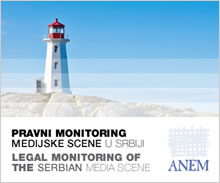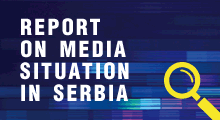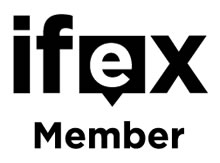20. 12. 2010
THE FOURTH ANEM MONITORING PUBLICATION
Read the fourth issue of the specialized ANEM Publication "Monitoring of the Media Scene in Serbia" that contains:
- The Introduction (with summarized results of legal monitoring of the media scene in Serbia during the period July-November 2010, and a short description of the Publication's contents),
4 expert authors' texts:
- Obstacles on the road towards a new regulatory framework for the media in Serbia - the author: Slobodan Kremenjak, attorney at law (the author writes about the drafting of regulations as one of the major obstacles for the progress of the media regulatory framework; citing the examples of the creation of several laws since 2008 to date, the author points out the unacceptable practice of the authorities to first establish expert working groups, only to ignore them later and write laws without their participation; the text gives answer to the question what are the consequences of such attitude of the authorities towards the media sector)
- Lost motivation for the transition to digital - the author: Nebojsa Samardzic, attorney at law (why the motivation of all stakeholders is important for a successful digital transition; what are the consequences of the loss of it; whose interests are wrongly recognized; whose and what needs have insufficiently been taken into account during the planning of the process that have a significant impact on its implementation; what is the solution for such situation; through these answers, the author analyzes the doubts that are slowing the path to digital transition)
- Strategy, Study, Summary - the author: Snjezana Milivojevic, PhD (through a retrospective of the work on the Media Strategy, the author points out the advantages and disadvantages of the process, and particularly explores the basic weaknesses, as well as values, of the Media Study; the role of the competent Ministry in this process and its capability to adequately respond to its task; how the media sector has coped with the challenges of the adoption of this strategic document; what is the fundamental gain of the creating process of Media Strategy)
- New media - new policies? - the author: Maja Rakovic, MA (the key international references for the Serbian media policy are media standards of the Council of Europe and the EU acquis in the field of media and information society; the author explains the differences and complementarities of their media policies, as well as the response of Europe to changes in the media environment - the debate on the topic: what kind of media policy is needed for digital media environment, and the new concept of the media; the author also proposes ways of how Serbia can join new processes, despite of uncompleted "old" transition reforms; this text provides important guidelines that can be useful for future work of the Serbian Media Strategy)
and the fifth text,
- MC Newsletter - contribution of the Media Centre Belgrade - 2 authors' texts published in the online editions of the Media Center Newsletter: the first, "Danish Royal frame for Serbian picture" by Jovanka Matic, Phd, is discussing the framework for Media Development Strategy set by the Media Study, as well as the need to reflect specifics of our system in this strategic document; in the second, "If you can't beat them, sue them", journalist Milos Vasic writes about the court practice in media cases and its impact on freedom of expression.
The results of the conducted legal monitoring of the media scene in the period July-November 2010 were used in the selection of the topics treated in this Publication. These results pointed to the fact that, even after these five months, nothing in the media sector had significantly changed in 2010. Thus, the media regulatory framework is still not developed enough, nor it complies with European standards and regulations. Adoption of regulations has become a weak point in the media sector development, because they are changed and written without the participation of the media sector, although often with the pretense that its representatives have been asked and included in the process. Non-transparent work of authorities in this area leads to bad decisions and solutions provided in such laws, where the media suffer the most. All the more, the existing regulations are not implemented properly either. An example of this is the Digitalization Strategy. Although there are only 16 months left until the transition to digital television broadcasting, big uncertainties and ambiguities in the process badly affect its implementation; all activities are delayed, which raises legitimate questions about whether its planning has sufficiently taken into account the needs and interests of all stakeholders in this process that determine the pace of the preparation for the transition. New digital era will open new opportunities to the media, but will also put new challenges before them. It is therefore important to build an appropriate legal framework, which would recognize and properly regulate the media in accordance with their new concept, new functions and new technological environment. The Media Strategy should serve to set a framework for this. However, Serbia still does not have this important strategic document. The process of its development has begun but has not yet been completed and no one knows when it will be. It is not known what solutions it will offer, although the Media Study and recommendations of its authors, independent international experts, should have helped. Not even the set of 5 round tables dedicated to drafting the Media Strategy, which were in the focus this September, as well as the activities of all interested in the progress of the media sector, has contributed much to a simpler and more rapid formulation of this strategic document. On the contrary, it turned out that all of these had only additionally confused the competent Ministry, which was not capable of meeting the expectations and responding properly to this task. The entire process of the Strategy drafting only saw the successful endeavor of the media and journalists' associations (all but one), which have recognized the importance of the Strategy and managed to consolidate their stands around its fundamental principles. It however remains to be seen how the Strategy, once made, would be the basis for Serbia's entry into the necessary media reforms, or it would just be a new source of conflict between the media sector and the government.
Texts in this Publication are tackling these important media issues and show why the changes for the better in the media sector have not yet taken place in 2010.
The integral version of this bilingual Fourth Monitoring Publication can be downloaded here.
-
No comments on this topic.





